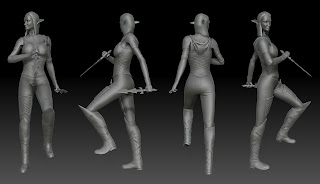The end approacheth...
After a marathon week of doing texturing and rendering non-stop, I finally finished (almost) all the still renderings for my written thesis presentation. Here are some of the renderings from previous semesters:
In the rendered views of the exterior of the Kobol that I had before, the camera angle was above the midline of the ship, which was making it look small. I got a suggestion from my instructor to keep the camera angle close to the ground and it would look closer to how someone would normally view it if they were standing next to it.
I added some glow and lens flares to the renderings to help them feel a bit more surreal. I know that the spaceship design isn't contemporary, but it's what I've been going with.
I spent most of my time this past week doing the final texturing of the interior of the Kobol. One of the main changes to previous iterations is the addition of an architectural element above the angel statue in the main waiting area. As I kept looking at, it just didn't look complete. So I took a rendering and began to sketch over top of it and finally came to an iteration that I thought worked.
Each one of the final rendering frames for the interior took between one and a half to five hours to finish rendering. With the amount of raytracing going on in the scene, it was no wonder. I used mainly Mental Ray architectural materials for the shaders, which rely heavily on reflected light/color within your scene. They do a really good job at creating metals and polished surfaces, which is what comprises most of the interior of the ship.
The plants were what was a main cause of grief in terms of rendering times and memory requirements. I used a bunch of plants from the XFrog libraries, all of which are pretty high resolution. In addition, the textures that the leaves have on them also use an alpha channel to get the transparency. The way that Mental Ray handles raytracing through the alpha channels is apparently very time consuming. Thus the hike in render time.

I also had to deal with some problems where some of the plants weren't rendering at all when I went to batch render. I have been referencing the plants in so that I woudn't have to deal with the huge file size associated with just importing the files in. In addition, I have been instancing some of the plants rather than just copying them. That allows for a "copy" of the geometry to be made, but the data that created basically links back to the original geometry and just saves transformation, rotation, and scale data. I did some investigation and discovered that the plants I had imported that were grouped weren't being recognized as true instances when render time came around, so I cringed and just duplicated the plants. My file size increased about 130MB, which is a lot for a 3D file, but it is still manageable by Maya.

I also spent some time working with the procedural texture generation program Genetica Studio. It allows you to mix a bunch of procedural texture nodes to create a high-resolution, seamless texture. I used it for most of the marble and stone textures as a base and then added some more photographic texture on top of the images I created.
I also created a depth pass for each of the scenes I rendered out. This allows me to do a quick depth of field blur to the scene anywhere I want to rather than relying on Maya to generate one that I have no control over in post.
Overall, I am satisfied with the results. It definitely adds a different flair to the model, but the marathon texturing session isn't one I ever want to repeat... like that ever happens in the industry!
Now that I have most of my stills done, I have been printing my final written thesis book. It is taking a while, but it has allowed me to work on other items as I go along. I still have some animated footage to work out, but for the most part, I think I am on my way to the end.




















